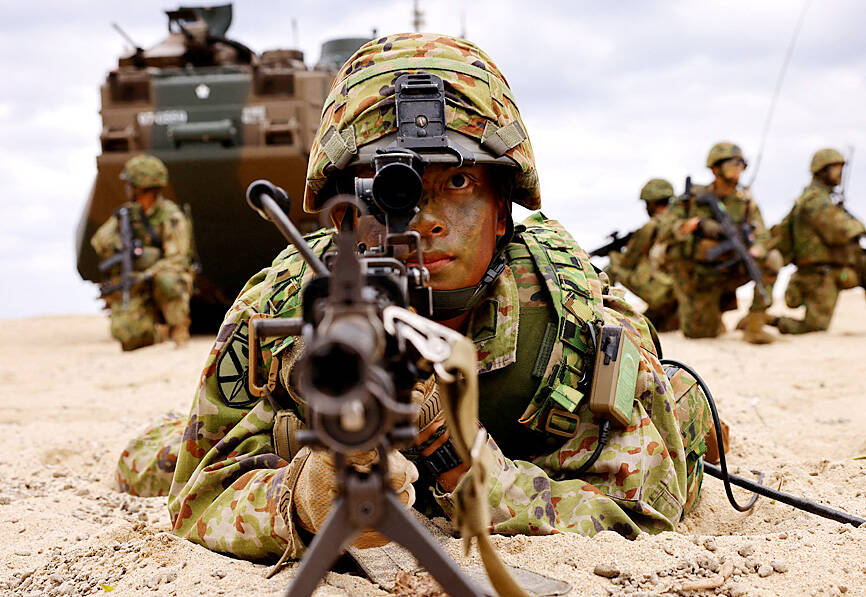Japanese marines in amphibious assault vehicles yesterday stormed an island beach at the edge of the East China Sea in a simulated attack to dislodge invaders from territory that Tokyo worries is vulnerable to attack from China.
As tensions run high with neighbors China, Russia and North Korea, the drill on the southwest island of Tokunoshima capped an 11-day series of exercises nationwide dubbed 05JX, meant to show the readiness of ground, sea and air forces to defend Japan’s territory and infrastructure, including nuclear power plants.
“The goal of JX is to show that if there is an emergency situation resulting from an attack, that we are able respond in a joint way,” Japan Self-Defense Forces Chief of Staff, Joint Staff General Yoshihide Yoshida said after observing the drill on Tokunoshima.

Photo: Reuters
The Chinese Ministry of National Defense could not be reached for comment on the drills.
Japan Ground Self-Defense Force amphibious assault vehicles launched from two Japan Maritime Self-Defense Force landing ships anchored offshore. Other troops arrived in semi-inflatable rubber boats, with heavy equipment carried to shore on military hovercraft.
Unlike many of the beaches along Japan’s southwest island chain stretching toward Taiwan, the one on Tokunoshima does not have a coral reef that would make military operations more difficult.
The scope and pace of military exercises in Japan are likely to increase over the next few years, including with US forces, after Japanese Prime Minister Fumio Kishida in December last year unveiled the country’s biggest military buildup since World War II, with a pledge to double defense spending over five years.
Kishida has warned that East Asia could be the next Ukraine, if China, emboldened by Russia’s assault on its neighbor, attacks Taiwan.
The ¥43.5 trillion (US$290.9 billion) in planned spending would go to new weapons such as longer-range missiles as well as to increase stocks of spare parts and munitions to fight a sustained conflict.
However, the yen’s sharp decline this year has forced Japan to cut back on some planned purchases, including new models of the US-made Chinook helicopters that Japan’s military used in the Tokunoshima drill.

‘CHARM OFFENSIVE’: Beijing has been sending senior Chinese officials to Okinawa as part of efforts to influence public opinion against the US, the ‘Telegraph’ reported Beijing is believed to be sowing divisions in Japan’s Okinawa Prefecture to better facilitate an invasion of Taiwan, British newspaper the Telegraph reported on Saturday. Less than 750km from Taiwan, Okinawa hosts nearly 30,000 US troops who would likely “play a pivotal role should Beijing order the invasion of Taiwan,” it wrote. To prevent US intervention in an invasion, China is carrying out a “silent invasion” of Okinawa by stoking the flames of discontent among locals toward the US presence in the prefecture, it said. Beijing is also allegedly funding separatists in the region, including Chosuke Yara, the head of the Ryukyu Independence

UNITED: The premier said Trump’s tariff comments provided a great opportunity for the private and public sectors to come together to maintain the nation’s chip advantage The government is considering ways to assist the nation’s semiconductor industry or hosting collaborative projects with the private sector after US President Donald Trump threatened to impose a 100 percent tariff on chips exported to the US, Premier Cho Jung-tai (卓榮泰) said yesterday. Trump on Monday told Republican members of the US Congress about plans to impose sweeping tariffs on semiconductors, steel, aluminum, copper and pharmaceuticals “in the very near future.” “It’s time for the United States to return to the system that made us richer and more powerful than ever before,” Trump said at the Republican Issues Conference in Miami, Florida. “They

GOLDEN OPPORTUNITY: Taiwan must capitalize on the shock waves DeepSeek has sent through US markets to show it is a tech partner of Washington, a researcher said China’s reported breakthrough in artificial intelligence (AI) would prompt the US to seek a stronger alliance with Taiwan and Japan to secure its technological superiority, a Taiwanese researcher said yesterday. The launch of low-cost AI model DeepSeek (深度求索) on Monday sent US tech stocks tumbling, with chipmaker Nvidia Corp losing 16 percent of its value and the NASDAQ falling 612.46 points, or 3.07 percent, to close at 19,341.84 points. On the same day, the Philadelphia Stock Exchange Semiconductor Sector index dropped 488.7 points, or 9.15 percent, to close at 4,853.24 points. The launch of the Chinese chatbot proves that a competitor can

‘VERY SHALLOW’: The center of Saturday’s quake in Tainan’s Dongshan District hit at a depth of 7.7km, while yesterday’s in Nansai was at a depth of 8.1km, the CWA said Two magnitude 5.7 earthquakes that struck on Saturday night and yesterday morning were aftershocks triggered by a magnitude 6.4 quake on Tuesday last week, a seismologist said, adding that the epicenters of the aftershocks are moving westward. Saturday and yesterday’s earthquakes occurred as people were preparing for the Lunar New Year holiday this week. As of 10am yesterday, the Central Weather Administration (CWA) recorded 110 aftershocks from last week’s main earthquake, including six magnitude 5 to 6 quakes and 32 magnitude 4 to 5 tremors. Seventy-one of the earthquakes were smaller than magnitude 4. Thirty-one of the aftershocks were felt nationwide, while 79